The ‘safety’ in ‘food security’.
Posted by Bernhard Merget on Thursday 14 May 2015
I’m a colleague working on food safety within the Cells and Molecular Sciences group at the James Hutton Institute in Dundee. Additionally, I am a member of the Centre for Human and Animal Pathogens in the Environment (HAP-E) at the institute. I read the SEGS blog post about food security, and wanted to add to that I also have reservations – albeit from another perspective – about how the term is defined and used.
I see new articles about food security getting published every day in newspapers, blogs and scientific journals. It is one of the most important topics for humanity, especially within the context of a changing environment (e.g. climate change) and an increasing population. As Deb noted in her earlier post, the Food and Agriculture Organization of the United Nations (FAO) defines the term as:
“When all people, at all times, have physical and economic access to sufficient, safe and nutritious food to meet their dietary needs and food preferences for an active and healthy life.”
Unfortunately, its definition is then narrowed down by the focus on the three pillars, also specified in the declaration: Food availability, Food access and Food use. This focus excludes the word ‘safe’, which is part of the initial definition.But, food safety is actually an integral part of food security, and I believe it is a mistake to forget that.
At present food safety is often treated independently to research on food security. Hazards in food are monitored and evaluated within the hazard analysis critical control point (HACCP) system, which was established in 1997 as an important tool for safety management. With an increase in distribution of food and processing steps, new tools to evaluate safety have been developed within this framework, including quantitative risk assessments. Now, not only can individual steps in the chain be evaluated for safety, but also the entire processing chain – i.e. from farm to fork. For risk assessors, this has opened up the scope of their work to encompass the wider environment beyond a single processing unit.
Through this process, those of us who focus on food safety are suddenly finding that we are evaluating the same relationship networks as our colleagues who work on food security. Very often we are finding food security and food safety interrelate. For example, if food is cold at every point in a distribution chain (a ‘cold chain’) then this benefits both potential access to food (increasing supply by preventing loss to contamination), as well as food safety.
I do not understand why there is little knowledge exchange between researchers working on food security and food safety. However, if this situation was to change, and we were to better connect these fields, I think many new questions would arise, and challenges might be differently framed. For example;
- Is it better to make food available, even if the safety is not guaranteed?
- Which measures are effective in both research fields and improve food safety and security?
- How does implementation of a system for safety (e.g. HACCP) influence other parameters relevant to food security (e.g. lower food access due to higher costs)?
- What are the minimum requirements for ‘safe food’? Should these minimum requirements be lower in developing countries in order to increase food access?
We need answers to all these questions, and more, if we are to make progress towards meeting the FAO objective to substantially increase food security. To help achieve this, I think it is vital to encourage knowledge exchange between both research fields. There are already some good examples from other sectors that we can learn from. For example in recent years, the ‘One health’ initiative has been established in the public health sector, to understand transmission of infectious diseases between humans, animals and other vectors, by establishing collaboration between physicians, veterinarians, dentists and environmental scientists. This may be an opportune moment to consider if we need an analogous approach to work on food safety and security. Might a ‘World Food’ approach help us to provide a forum to address the current and future food-related challenges that face humankind?







Comments
Comment entitled: Interesting thoughts, submitted by Joshua Msika at 16:57, 19/05/2015
The safety aspect of food security had been off my radar completely. Thanks for bringing it up.
I'll be working on local food in the next RESAS programme and I'm interested in the interaction between the 'localness' of food production and other aspects, including both food security and food safety.
Post new comment